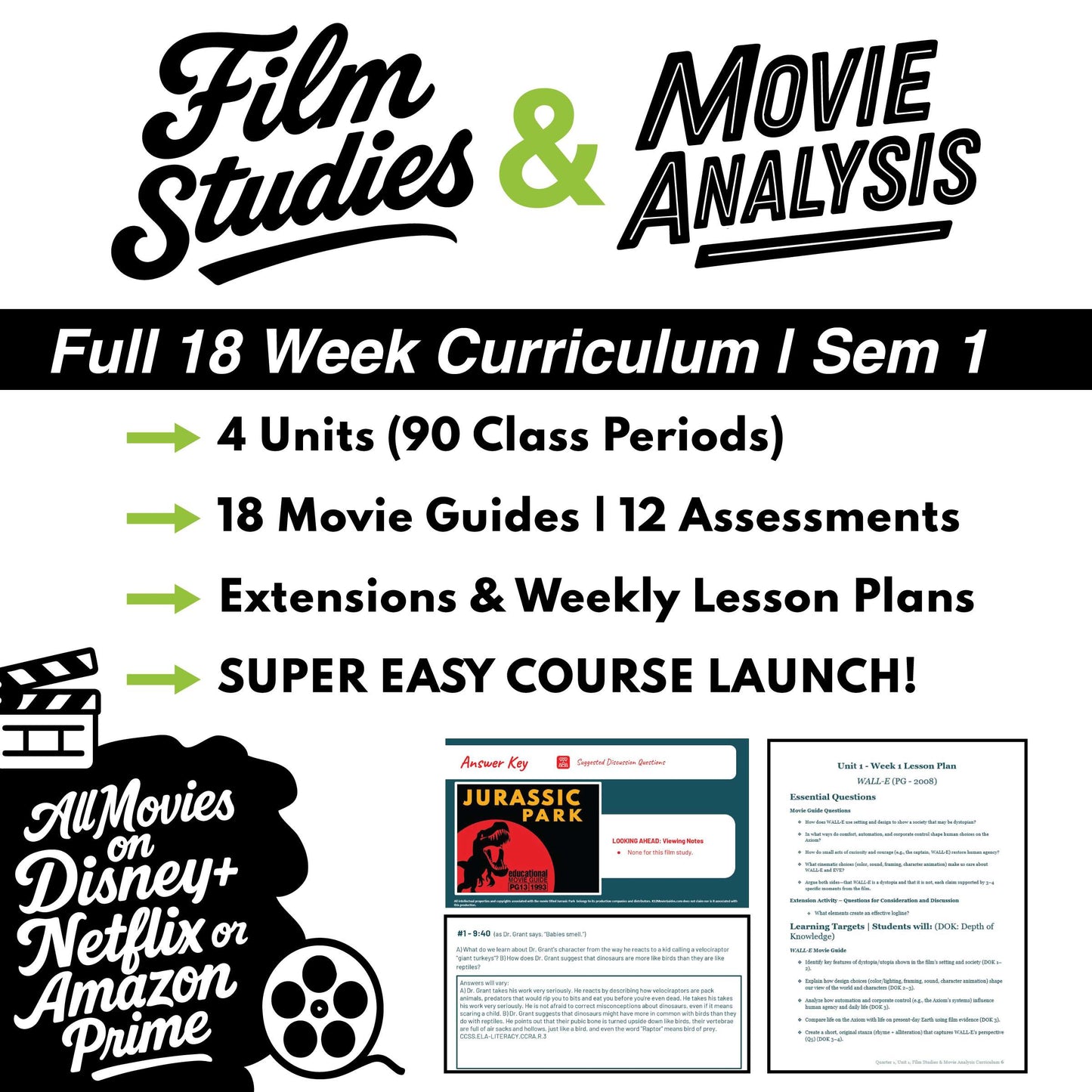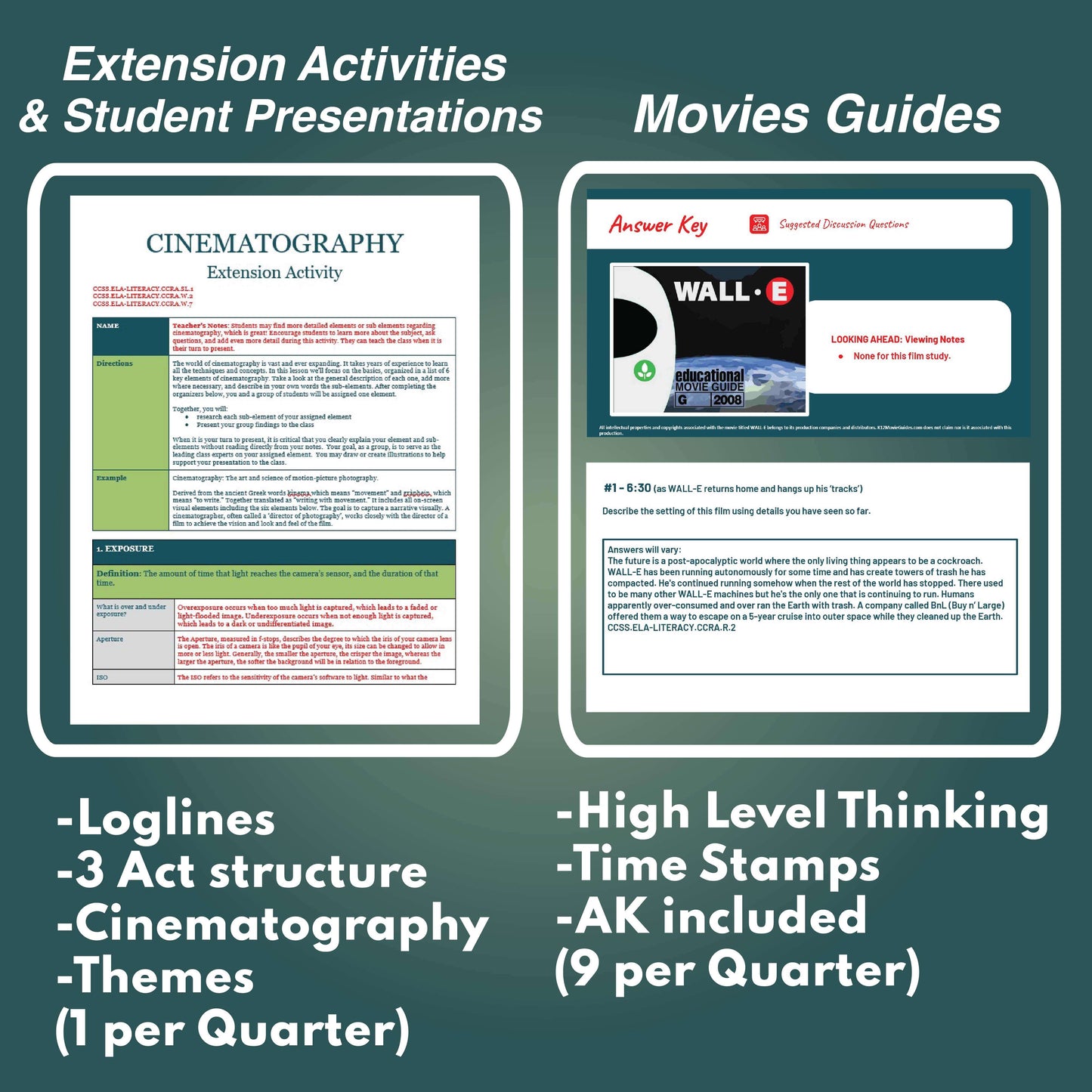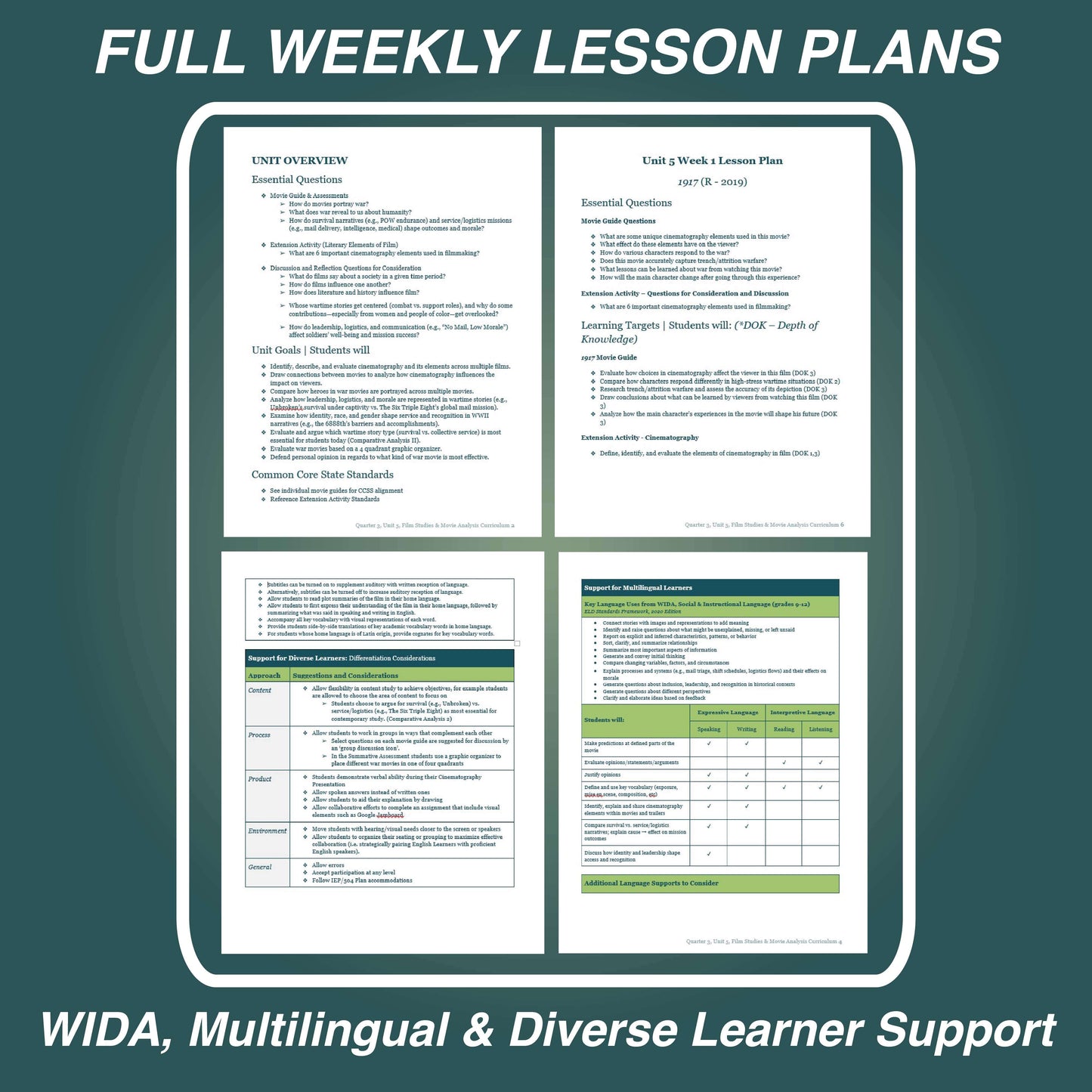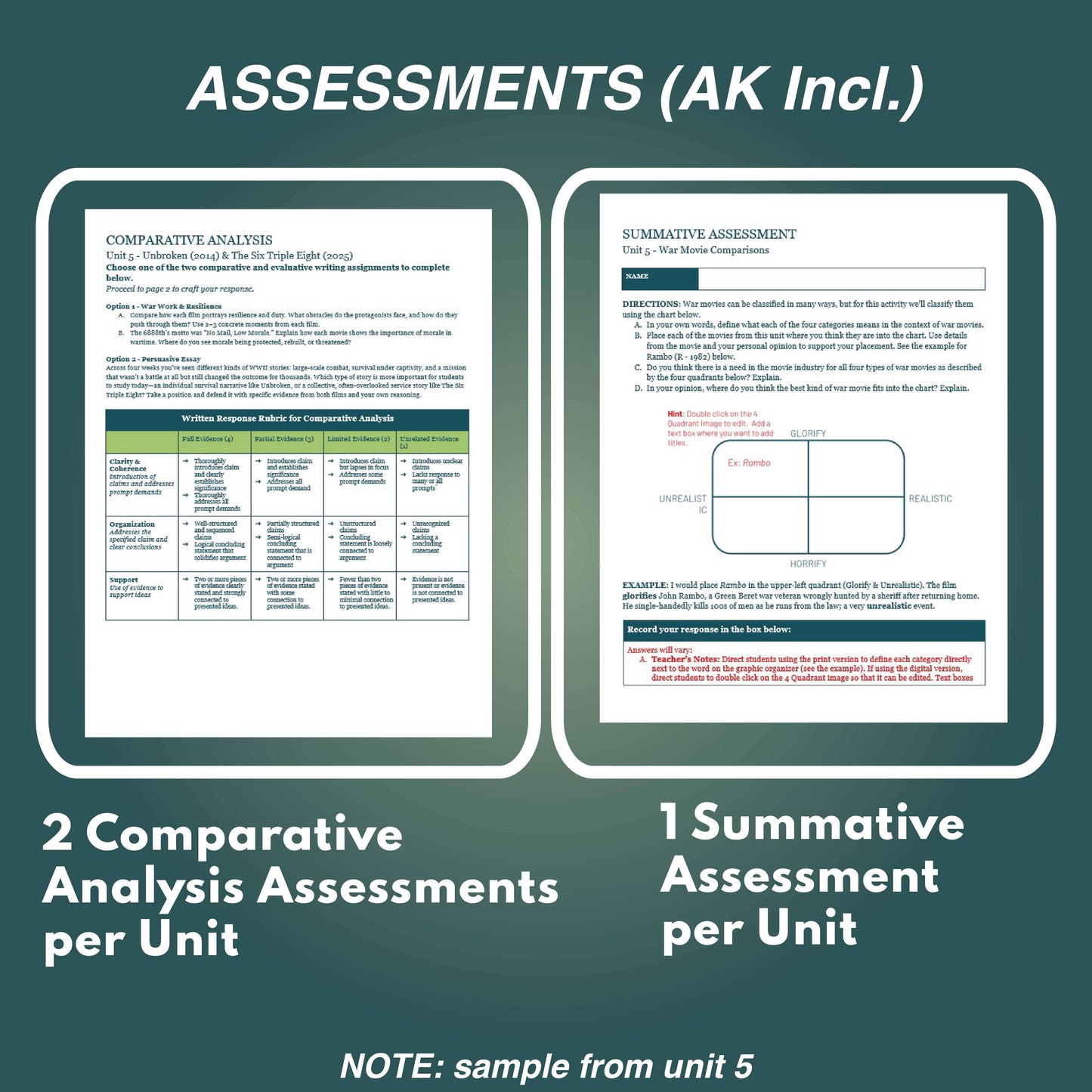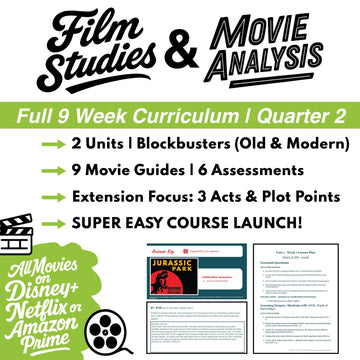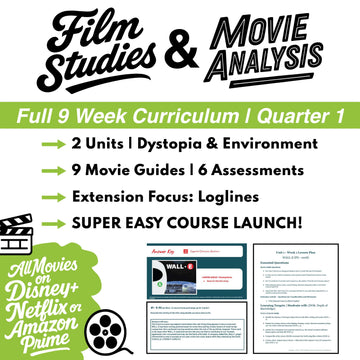K12MovieGuides
Film Studies & Movie Analysis Elective Curriculum for High School | Semester 1 | SAVE 20%
Film Studies & Movie Analysis Elective Curriculum for High School | Semester 1 | SAVE 20%
Couldn't load pickup availability
This Film Studies & Movie Analysis Elective Curriculum Semester 1 is a complete, standards-aligned film-analysis for entry-level high school classes (and mixed-readiness groups). This curriculum prioritizes clear scaffolds, broad appeal, and school-friendly films that are easy to stream and find.
Easy access to films (with subtitles):
Core titles in this curriculum are available on the three major platforms most classrooms already use: Disney+, Netflix, and Amazon Prime Video. Subtitles/closed captions are excellent on all three services, supporting multilingual learners and accessibility. (See Film Availability reminder for more below) s of 2025, every featured film is streaming on one or more of these platforms; however, catalogs change, so teachers should verify availability before the lesson day and have a backup plan if a title rotates.)
Will this meet my needs?
Check out the full description below and if that isn’t enough get a 100% free course preview here!
Or, save 40% and get the full year curriculum here!
Semester 1 Outline:
Unit 1 — Dystopia & Environment + Loglines (Extension)
- WALL·E (G – 2008) — Visual storytelling of dystopia; environmental motifs; how convenience and tech design shape human agency. Students analyze symbols (trash, greenery, the “plant”), cause and effect chains, and tone without heavy dialogue.
- The Social Dilemma (PG-13 – 2020) — Design ethics and persuasive algorithms; attention economies; personal tech habits. Students test a 48-hour design/policy tweak and reflect on outcomes with evidence.
- Before the Flood (PG – 2016) — Global climate drivers (energy, land use/deforestation, food systems) and policy levers. Students map a four-step cause and effect pathway and compare emphasis with other films.
- David Attenborough: A Life on Our Planet (PG – 2020) — Witness narrative + solutions (rewilding, renewables, sustainable practices); students draft a simple systems map connecting tech choices to environmental impacts.
Unit 2 — The Underdog
- Rudy (PG – 1993) — Grit, gatekeeping, and community support; students evaluate how constraints and allies shape an underdog’s path.
- Greater (PG – 2016) — Work ethic vs. talent; mindset under loss and doubt; students trace decisions to outcomes with scene evidence.
- Edward Scissorhands (PG-13 – 1990) — Identity, otherness, and belonging; reading tone, symbolism, and satire as they relate to “underdog” status.
- The Karate Kid (PG – 1984) — Mentorship, discipline, and ethical competition; students analyze how training sequences develop character theme.
- The Boy Who Harnessed the Wind (PG – 2019) — Ingenuity, resource scarcity, and community problem-solving; students connect obstacles → strategy → impact.
Unit 3 — Blockbusters (Oldies) + Three Acts & Plot Points (Extension)
- Toy Story (G – 1995) — Jealousy, identity, and teamwork. Students track how rivalry becomes partnership and map act turns across the toy-room, gas station, and Sid’s house set pieces.
- The Princess Bride (PG – 1987) — Genre satire and clear archetypes. Students examine how wit, duel scenes, and constant reversals reveal character goals and theme.
- Jurassic Park (PG-13 – 1993) — Technology, control, and chaos. Students evaluate how suspense and spectacle support theme and broad four-quadrant appeal.
- Aladdin (G – 1992) — Agency, honesty, and power. Students analyze how musical numbers deliver exposition, advance character arcs, and drive the major plot points.
- Home Alone (PG – 1990) — Initiative and problem-solving. Students study comedic escalation, planning sequences, and payoff timing in the third act.
Unit 4 — Blockbusters (Modern) + Three Acts & Plot Points (Extension)
- National Treasure (PG – 2004) — Research puzzles and civic myth. Students analyze heist beats, clue chains, and the ethics behind mission choices.
- Spider-Man: Across the Spider-Verse (PG – 2023) — Identity, belonging, and the tension between fate and choice. Students explore “canon events,” visual storytelling, and an intentional cliffhanger structure.
- Avatar (PG-13 – 2009) — Colonialism, empathy, and ecological ethics. Students trace hero’s-journey beats and study world-building as the audience hook.
- Black Panther (PG-13 – 2018) — Leadership, legacy, and reform. Students analyze the antagonist’s argument, compare leadership styles, and consider how culture and production design sharpen theme.
What’s included (teacher-ready & customizable)
- Planning & pacing for each quarter and unit (day-by-day breakdowns that align with movie guides and extension activities).
- Movie Guides - Student Copy (SC) & Answer Key (AK) for every title with short-answer and evidence-based writing prompts.
- Extension strands that spiral across the year and include student presentations:
- Loglines & Student Presentations — Students learn to compress a full story into a crisp 1–2 sentence pitch that names the protagonist, antagonist, setting, rising action, problem, and resolution. They reverse-engineer real examples (e.g., Jurassic Park, Home Alone), compare strong vs. weak versions (fixing missing elements in an Aladdin logline), and build reusable templates.
- Three Acts & Plot Points & Student Presentations — Students diagram classic 3-Act structure (Hook, Plot Point 1, Midpoint, Plot Point 2/Epiphany, Climax, Aftermath), locate those beats in specific scenes, and use the model to compare “Oldies” and “Modern” blockbusters in short presentations and comparative writing.
- Assessments for each unit: Two Comparative Analyses and a Summative Assessment task:
- Unit 1 - Dystopia & Environment | Summative Preview: Students synthesize design choices and environmental drivers from the unit’s films, then present a short, evidence-based proposal that connects human agency, everyday habits, and near-future outcomes (with a simple systems view).
- Unit 2 - The Underdog | Summative Preview: Students define and defend what makes an underdog and a hero, then connect film ideas to real life through a brief community interview and reflection on obstacles, support, and impact.
- Unit 3 — Blockbusters (Oldies) + Three Acts & Plot Points | Summative Preview: Students evaluate how heroes and villains read across generations, argue which are most relatable today, and support a ranked list; or conduct a structured interview with an older adult and synthesize insights about how audience relatability shifts over time.
- Unit 4 — Blockbusters (Modern) + Three Acts & Plot Points | Summative Preview: Students design a concise “global appeal” organizer that identifies elements modern blockbusters need for U.S. and international audiences, then chart several films against it with brief justifications
Standards alignment (ELA strands)
Every unit targets Common Core Anchor Standards across Reading, Writing, Speaking & Listening, and Language. Strand-by-strand coverage (R.1–R.9, W.1–W.9, SL.1–SL.3, L.4–L.5) with explicit standards called out on each Movie Guide and assessment.
Digital or Print—your choice
- Digital workflow: Turn on Drive › Settings › “Convert uploads to Google Docs editor format,” then drag in the folder. Docs/Slides are ready for Classroom.
- Print workflow: DOCX and PPTX files are classroom-ready; print slide decks via File → Print → Handouts → 2 per page.
Film Availability Reminder:
As of 2025, every featured film is streaming on one or more of these platforms; however, catalogs change, so teachers should verify availability before the lesson day and have a backup plan if a title rotates. Movie titles were selected that have a high chance of remaining on these platforms unlike some movies that are only available for a limited time. We include a simple spreadsheet that shows which of the 3 platforms (Disney+ / Netflix / Amazon Prime Video) every movie is currently (2025) streaming on.
Does K12MovieGuides offer two full Film Elective Curriculum Options?
Yes! Read below to find out which one is best for your needs?
Film Studies & Movie Analysis: a plug-and-play film curriculum that every class can access?
- This is a lighter, more accessible companion to our original program—built for introductory learners and mixed-readiness classes. It uses mainstream, easy-to-stream films available on the big three platforms (Disney+ / Netflix / Amazon Prime Video) with strong subtitles for accessibility.
- Audience: Grades 9–12 general ELA, newcomers, co-taught classes.
- Content: School-friendly slate (mostly G–PG-13), with only two R-rated titles
- Scope: 36 movie guides, one simple schedule (no alternates to juggle), streamlined comparative tasks.
- Standards: Hits core CCSS strands while keeping cognitive load manageable.
Film as Literature & Cinematic Arts: a deep-dive, university-prep experience with canonical titles.
- This is designed for college-level or highly skilled high school students who thrive on challenging texts and seminar-style analysis. It features more mature, gold-standard films widely recognized for film-study rigor.
- Audience: Honors, AP bridge, dual-enrollment, advanced electives.
- Content: Heavier themes and academic film language; titles chosen for canonical significance and depth.
- Scope: 45 movie guides (vs. 36 in the other edition), with alternate schedules and assessments to support varied pacing and deeper comparative work.
- Outcomes: Extended research, richer theory/application, and sustained argumentative writing—ideal for students aiming at college-level analysis.
How can I contact K12MovieGuides?
Feel free to email us anytime at k12movieguides@gmail.com
Terms & Conditions of Use | Copyright | DMCA
You can:
Use this product for your own personal classroom forever
Ask your school or district to purchase this curriculum for you (or ask about school site and district wide licensing)
You cannot:
Upload this product anywhere that allows unsecured access to where other teachers use it freely
Send this product to other people including emailing, printing copies, or otherwise sharing digitally
Use this product for your personal commercial use
Frequently Asked Questions
Q: Do I have to use all of the films included in each unit?
A: No, although it is recommended. When another film not included is more desirable for your students, it should be noted that teachers may need to prepare movie viewing questions and adjust any activities or assessments to reflect the content of the substituted film.
Q: Can Film Studies & Movie Analysis Curriculum be substituted to fulfill high school graduation requirements for an English Language Arts course?
A: Film Studies & Movie Analysis Curriculum was written with the purpose of supporting elective or enrichment selections at the high school level. Therefore, not all Common Core English Language Arts standards are explicitly introduced and spiraled as would be expected with a more traditional English course. However, K12Movieguides.com recommends working with your school or district if there is interest in using Film Studies & Movie Analysis Curriculum as a resource to supplement a core course. A Standards Alignment Guide has been provided in the “Get Started” materials for the entire year course for your reference and use.
Q: Can Film Studies & Movie Analysis Curriculum be used at the middle school level?
A: Yes. It is recommended that instructors consult with their site administrator or administrative team to determine the appropriateness of the themes and content included in each unit in relation to a middle school-age audience.
Q: What if my class can’t finish a film before the assessment window?
A: Use the guide’s pause-points to split the film across days and push any end-of-film essays by one class. For comparisons, allow clip-based evidence from previewed scenes only; do not require scenes students haven’t watched.
Q: Can I show clips instead of the full film?
A: Yes—especially for pacing or permissions. Choose clips that align with the existing question timestamps and keep the chronological flow. Document the clip start/stop times on the guide so students can cite accurately.
Q: How do I handle PG-13/R content and permissions?
A: Follow site policy. Provide a one-paragraph alternate task (same skills: theme/argument/craft) drawn from the same film’s trailer, stills, and script excerpts or from a school-approved alternate title for which you will need to create your own movie guide questions and alter the provided assessments.
Q: How do I support English Learners without diluting rigor?
A: Keep captions on; pre-teach 4–6 words; offer sentence starters (“One film-craft choice that strengthens the theme is…”) and allow oral responses recorded on a device for select prompts. Grade with the same rubric.
Q: What if different classes are using different streaming versions (ads, runtimes)?
A: Instruct students to cite scene description + approximate time (e.g., “Rumble under the highway, ~1:30”) so evidence stays verifiable even if timestamps drift.
Q: Can I swap film order inside a unit?
A: You can, but keep each unit’s Comparative Analysis pairings intact (Weeks 1–2 together; Weeks 3–4 together; Week 5 feeds the Summative). If you reorder, update pacing notes and any lead-in vocabulary.
Q: How should students use AI tools (if allowed by school policy)?
A: Permit AI for brainstorming or clarifying vocabulary only; prohibit AI-written evidence/analysis. Require in-class notes with timestamps to demonstrate original viewing-based thinking.
Q: How do I adapt for students with sensory sensitivities?
A: Offer volume-reduced seating, noise-reducing headphones (if allowed), or a transcript + stills alternative for intense scenes; grade the same skills with equivalent prompts.
Terms and Conditions © 2022 K12MovieGuides.com. All rights reserved. Purchase of this product allows the purchaser the right to reproduce the pages (digitally or in print) in limited quantities for the purchaser’s classroom only. Duplication or distribution for/to another individual, school, school district, private school, or any other business or education agency, or for commercial purposes, is strictly forbidden without written permission from the publisher, K12MovieGuides.com. Copying any part of this product and placing it on the Internet in any form (even a personal/classroom website) is strictly forbidden and is a violation of the Digital Millennium Copyright Act (DMCA). By posting this product freely on the internet, anyone can copy or download it and use it for free. Should a violation occur, the publisher will seek to enforce all rights available to it under the DMCA or other federal and state copyright laws.
Share
